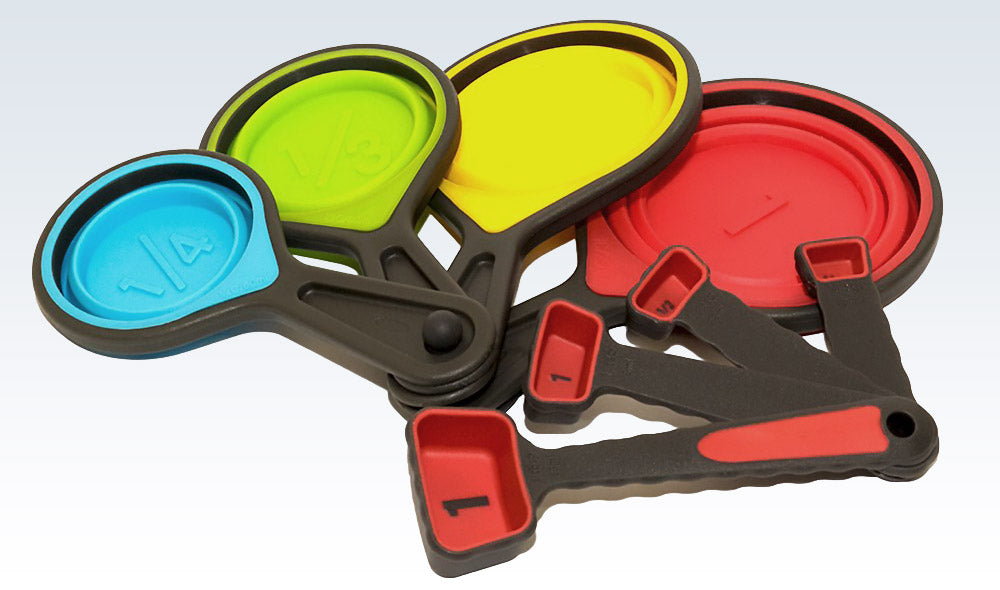What if you could pile your plate as high as you wanted, without using measuring cups or thinking about body mass index (BMI)?
Two Cups Per Meal
The obesity crisis is real. Are you concerned with nutrition? Statistics indicate that 40 percent of American adults were obese in 2015–16, up from 34 percent in 2007–08. Sixty percent of the U.K. population is overweight or obese from eating too much and exercising too little. The causes are many, and the response leads an increasing number of people to dieting.

A weight trainer held up a collapsible set of silicone cups while extolling the notion that a portion of food is half a cup. Looking around the room at people ranging from 5 feet to over 6 feet tall (1.5–1.9 meters) and from weighing from 150 to 300 pounds (68–136 kilograms), makes me wonder, could the identical size portion possibly be appropriate for everyone? Clinical researchers have examined this question in a study with 798 participants. Does the following conclusion surprise you?
Given the lack of association between BMI and portion‐size preference, we suggest that factors other than portion size, such as differences in meal frequency, food type, plate clearing, or compensation at subsequent meals, may need to be considered to explain the increasing prevalence of obesity. —N. M. Reily, et al. 2016.
Breaking this down further, exercise, what we snack on, and how often we do so are greater indicators of obesity than main meal portion size. Also, the quality of each meal has a bearing. A 12-ounce portion of cream-filled cake carries more weight than a 12-ounce leafy green salad. “As decades of soda and TV dinners caught up with our waistlines, the U.S. diet industry grew bigger, faster, and smarter.” —PublicHealth.org.
BMI tables were not created to measure personal health. They were developed to approximate that of large populations. Hence, some body types may fall beyond the spectrum and still be healthy. Conversely, a large disparity (obese vs. overweight) is a cause for individual concern.

Matryoshka Space-Saving Collapsible Silicone Measuring Cups
Food quality and portion-size disparity conclusions are supported by several other studies. One of 666 British adolescents shares these findings:
Energy intake was found to be more likely to influence the development of obesity than the source of energy. Larger portion sizes of many high-energy-dense foods, including biscuits, cheese, cream, and cakes, were associated with a higher BMI. The portion sizes of only high-fiber breakfast cereals and carbonated high-energy soft drinks were associated with BMI among under-reporters. —Salwa A. Albar, et al. 2014.
Clinical studies on weight are notoriously controversial. Authors may be influenced by sponsorships or their personal fitness regimens. Another study conducted on 297 patients presents the following conclusion:
Reduced portion sizes and eating rates are associated with body mass index standard deviation score (BMI-SDS) reduction after 1 and 2 years. These findings suggest focusing on appropriate portion sizes and reduced eating rates in patient education programmes. —Torbahn G, et al. 2017.
Generally, human adult stomachs have an average volume of about one liter, which is a little more than one quart. As a muscle, the stomach can expand up to four liters, which is more than one gallon. Since contraction and expansion are required for digestion, filling it to maximum capacity can be uncomfortable. Leave room for this process called peristalsis.
The fitness consultant mentioned earlier recommends that each meal should total about two cups (half a liter) with MyPlate proportions. At less than capacity, this is designed for weight loss. ChooseMyPlate.gov imprints within our minds the relative proportions of balanced food groups.
On a plate, the ratio of protein and grains (carbohydrates) is equal (half a cup each). The amount of fruits or vegetables is twice the size of protein or grains. If one plate is not satisfying, a second helping should retain the same ratio of foods. Even though obesity is prevalent, eat balanced meals to remain healthy.
To support the writing of useful articles about nutrition, ClinicalPosters sells human anatomy charts, scientific posters, and other products online. You may sponsor specific articles, become a ClinicalNovellas Member, or remit a small donation.
ClinicalPosters sells human anatomy charts, scientific posters, and other products online to offset expense of the writing useful articles about nutrition. Slide extra posters into DeuPair Frames without removing from the wall.
Show your support by donating, shopping for ClinicalPins, becoming a ClinicalNovellas Member, or leaving an encouraging comment to keep the research going.
To support the writing of useful articles about nutrition, ClinicalPosters sells human anatomy charts, scientific posters, and other products online. You may sponsor specific articles or remit a small donation.
ClinicalPosters sells human anatomy charts, scientific posters, and other products online to offset expense of the writing useful articles about nutrition. Slide extra posters into DeuPair Frames without removing from the wall.
ClinicalPosters sells human anatomy charts, scientific posters, and other products online. You may remit a small donation or become a ClinicalNovellas Member.
You can support the writing of useful articles about nutrition by sponsoring specific articles, becoming a ClinicalNovellas Member, or remitting a small donation. Visible content is optimized for device size.







